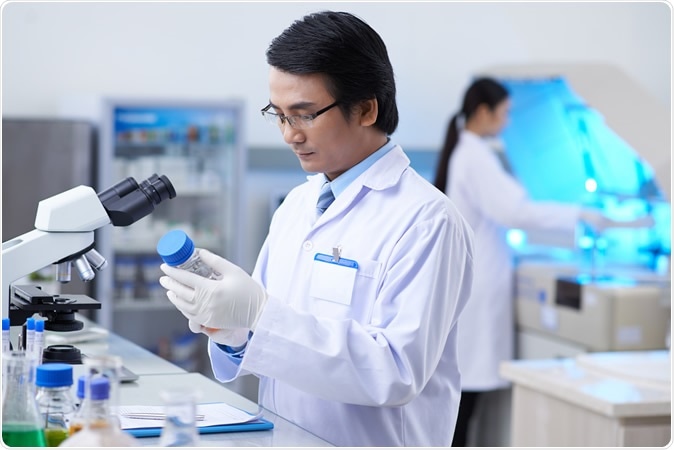Many recent studies have focused on how much it costs to bring a new drug to market in the light of increasing drug prices. Estimates range from $314 million to $2.8 billion. Most of this was based on proprietary data and was, therefore, not verifiable independently, attracting much criticism.
A new study published in JAMA and based on the new drugs approved by the US Food and Drug Administration (FDA) between 2009 and 2018 attempted to quantify the expenditure on research and development (R & D) required to introduce a new drug to market.

How much do drug companies spend on research and development to bring a new medicine to market? Image Credit: Dragon Images / Shutterstock
The study
The researchers retrieved data from the US Securities and Exchange Commission, Drugs@FDA database, and ClinicalTrials.gov, as well as the data published from clinical trials. The aim was to find out how much was spent (median and mean) on R & D for new drugs up to the point of FDA approval. This was treated as the capital required to develop the drug, at the cost of capital, that is, the amount to be invested that will yield the rate of return required to persuade the investor to make a given investment. It was set at 10.5% a year.
The researchers looked at all expenditures per year of drug development, including direct expenses and indirect personnel and overheads across all programs if available, or allocating a proportional amount for each in accordance with costing study practices. The sums were then converted to 2018 USD rates. Since the type and completeness of data varied between drugs, the investigators classified estimate quality as high, medium, or low. Thoroughly documented cost data was labeled high-quality estimates, while drug acquisitions, licensing agreements, and other late collaboration deals were low-quality estimates.
Failure costs were also documented using data on the aggregate success rate of clinical trials using a recent study on this topic, which shows that less than 14% of drugs entering phase 1 trials make it to approval, but 35% and 59% of phase 2 and phase 3 entries respectively.
The total R & D expenditure was then divided by the corresponding chances of success at each phase. These rates were then used to adjust the spending at each stage of development
The findings
The FDA approved almost 360 new drugs and biologics throughout the study that came from approximately 50 pharmaceutical companies.
Failed trials were also considered to adjust the costs of investment. The final median (middle value) capitalized investment on R & D for a new drug is estimated to be about $985 million, for a mean (average) investment of $1,336 million.
If only high-quality estimates are considered, the median goes up to about $1,050 million, and the mean goes down to $1,140 million. If potentially missing preclinical costs are included, the mean goes up to $1,800 million for drugs not acquired through purchase but is $2,215 million if all 63 drugs are included.
When classified by therapeutic area, the median estimate comes to $766 million for drugs acting on the nervous system, to $2,772 million for drugs to treat cancer or drugs which affect the immune system. The mean estimates come to $1,077 million and $4,461 million for these categories, respectively.
Limitations
The researchers were hampered by the unavailability of data relating to the development costs for many FDA-approved products. The disproportionate representation of smaller companies could have skewed the estimate towards a lower estimate since such firms likely have less to spend on drug development than larger pharmaceutical firms.
Secondly, the drugs included in the study tended to be more often orphan drugs, first-in-class rugs, and other non-generalizable drugs. Data inconsistencies between firms, differences in documentation policies, and analytical problems may all have potentially contributed to possible inaccuracies in the estimate. For instance, if the preclinical costs reported were too low, or if subsidies or tax credits were not included, this would affect the estimates.
The results were tested using varying success rates in clinical trials, expenditures on preclinical experiments, and cost of capital. This may account for the wide disparity between these rates and those of an earlier study that estimated oncology drug R & D costs at $780 million. The preclinical expenditure is difficult to pin down in all cases, but the researchers used the estimate adopted in earlier studies, of about 43% of the total capitalized costs for preclinical costs
The data refers mainly to smaller pharmaceuticals, orphan drugs, drugs for specific therapeutic applications, drugs that had passed through the fast-track approval channel, drugs that were first-in-class, and drugs that received approval from 2014 to 2018. The highest estimates are for cancer drugs and immunomodulatory drugs.
Implications
The researchers say, “Greater transparency around research and development costs is essential for analysts to check the veracity of claims by companies that the steep prices of new drugs are driven by high development outlays.” Though they agree that such outlays are “undoubtedly high,” they insist that greater knowledge of how much is actually spent at this stage is important. “This knowledge can inform the design of pricing policies that give adequate rewards for innovative drugs that bring value to health care systems,” they conclude.
Journal reference:
Wouters OJ, McKee M, Luyten J. Estimated Research and Development Investment Needed to Bring a New Medicine to Market, 2009-2018. JAMA. 2020;323(9):844–853. doi:10.1001/jama.2020.1166